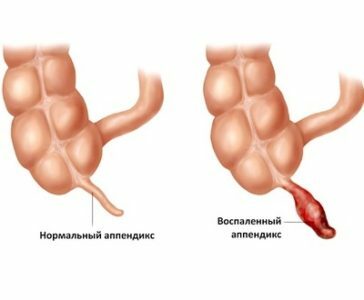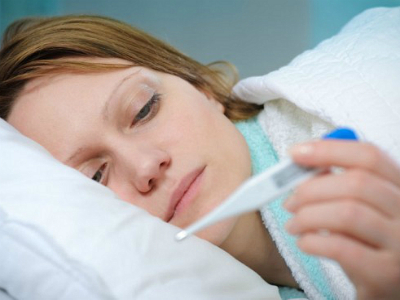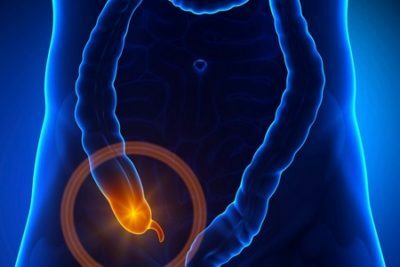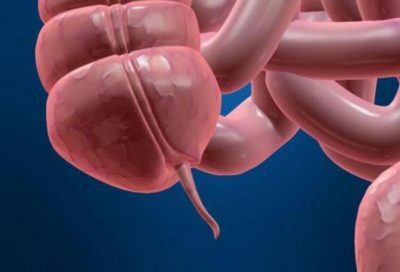1 Etiology of the disease
Appendicitis refers to acute surgical diseases of the abdominal cavity. The exact cause of this disease is not established. Possible predisposing factors include infection, blockage of the appendix with a stiff stone, improper nutrition, thrombosis of blood vessels. Most often this pathology develops in the adolescent. Little children get sick less often.
Do you have gastritis?
GALINA SAVINA: "How easy is it to cure gastritis at home for 1 month. A proven method - write down a recipe. ..!"Read more & gt; & gt;
Signs of appendicitis in adolescents are practically no different from those of adults. With the development of this disease the following symptoms are possible:
- fever;
- abdominal pain;
- lack of appetite;
- nausea;
- vomiting;
- loose stool;
- child lethargy;
- frequent breathing and palpitations;
- pallor of the skin.

We recommend that you read
- The main signs of appendicitis in adults
- Rules for feeding after appendicitis removal
- How to recognize appendicitis in a child
- Effective remedy for gastritis and stomach ulcer
Some patients have constipation and urination disrupted( it becomes frequent).The urine is darker. In most cases, appendicitis occurs in an acute form. In chronic course, symptoms are poorly expressed. Such patients complain of constant, minor pain.
2 Pain syndrome in the pathology of
The first signs of appendicitis in a child are dyspeptic disorders and pain. The disease begins acutely. Parents of these children almost immediately call an ambulance or call a doctor. Pain is the main symptom of appendicitis. It has the following features:
- is localized in the upper abdomen or right side;
- in the early stages is diffuse;
- intensive;
- grasping;
- is strong;
- is often combined with nausea, vomiting and diarrhea;
- migrates with time;
- forces a sick teenager to take a comfortable pose;
- lasts for several hours;
- often gives in the right foot;
- occurs mainly at night or in the evening;
- amplifies when driving.

The development of appendicitis in adolescents goes through several stages: catarrhal, phlegmonous, gangrenous inflammation and perforation. In the first 12 hours, acute catarrhal inflammation develops. With it, there are no signs of suppurative appendectomy. Children have pain in the stomach or navel. Pain blunt and moderate. They can be mistaken for an exacerbation of gastritis.
During this period, patients do not always seek help. In this stage, there is often a single vomiting. Gradually, the localization of pain changes. This largely depends on the location of the appendix. With the pelvic location of the appendix, the pain shifts downwards, it is felt in the lower part of the abdomen.
-
 IMPORTANT TO KNOW! Gastritis? Ulcer? To have a stomach ulcer not turned into cancer, drink a glass. ..Read the article & gt; & gt;
IMPORTANT TO KNOW! Gastritis? Ulcer? To have a stomach ulcer not turned into cancer, drink a glass. ..Read the article & gt; & gt;
With a right-sided placement of the appendage, painful sensations arise in the right hypochondrium.
In this situation, you can erroneously suspect cholecystitis or hepatitis. With such a localization of pain, it can be irradiated to the shoulder. If the appendix is located behind the cecum( retrocetically), then this presents the greatest diagnostic difficulties.
The pain is felt in the lower back on the right. Painful syndrome in the navel area indicates the medial location of the appendage. With phlegmonous appendicitis, pain is more pronounced. It is pulsating and intense. The transition of pain from the upper parts to the iliac zone indicates a positive symptom of Kocher.

Phlegmonous appendicitis develops in the first 24 hours. Dangerous is gangrenous appendicitis. With it, the pain may temporarily fade or disappear completely. This sign indicates a purulent lesion, in which nerve fibers die.
3 First symptoms of
A constant symptom of appendicitis in adolescents is fever. In most cases, it does not exceed 38 ° C.With catarrhal appendicitis, the temperature rises to 37-38 ° C.In very severe cases, fever is observed up to 40 ° C.The rise in temperature is a reaction of the body to the inflammatory process. Its presence allows you to exclude other conditions with a similar clinical picture( renal colic).
-
 Gastroenterologist. IMPORTANT: "I beg you, if you started to worry about abdominal pain, heartburn, nausea, do not do gases. .."Read more & gt; & gt;
Gastroenterologist. IMPORTANT: "I beg you, if you started to worry about abdominal pain, heartburn, nausea, do not do gases. .."Read more & gt; & gt;

In the absence of treatment in the stage of gangrenous appendicitis, the temperature often falls. Dysuric phenomena in the form of reduced diuresis and difficulty in excretion are observed with pelvic and retrozekalnom location of the appendix. Children and adolescents often have a single, loose stool. Less common is constipation. This is due to the paresis of the intestine due to the necrosis of the nerves.
In the first 6-12 hours after the onset of pain, the following symptoms occur:
- dry mouth;
- frequent heartbeat;
- general malaise;
- excitement.
When palpation of the abdomen reveals soreness. The abdomen is soft. By the end of the first day, when phlegmonous inflammation develops, there is constant nausea. The heart rate reaches 90 beats per minute or more. The right side of the abdomen, when breathing, lags behind the left. Belly below, the stomach becomes firmer.
During this period positive symptoms of Sitkovsky, Rovsing, Shchetkin-Blumberg are revealed. Symptom Sitkovskogo is positive, if the finding of a teenager on his left side, there is pain in the ileum. Symptom Shchetkin-Blumberg positive, if the pressure on the abdominal area and rapid removal of the pain increases dramatically.
ADVICE FROM THE MAIN GASTROENTEROLOGIST
Korotov SV: "I can recommend only one remedy for the rapid treatment of Ulcer and Gastritis, which is now recommended by the Ministry of Health. .." Read testimonials & gt; & gt;
With gangrenous appendicitis, sensitivity decreases. An imaginary improvement of the state is observed. With palpation and external examination, bloating and a lack of peristalsis are found.
The greatest danger for adolescents is perforated appendicitis. With it, the perforation of the intestinal wall takes place. The pain becomes constant, and vomiting is multiple. When examining the oral cavity of patients, a dark plaque is revealed. In some adolescents appendicitis occurs lightning fast. The duration of the stages can vary.
4 Diagnostic methods and possible complications of
Every experienced physician is obliged to know the clinical, physical, laboratory and instrumental signs of appendicitis in adolescents that allow you to make a correct diagnosis. The presence of appendicitis in a child is indicated by the following symptoms:
- abdominal pain lasting more than 6 hours;
- presence of nausea or vomiting;
- positive symptoms of Shchetkin-Blumberg and Voskresensky;
- positive symptoms of Rovzing, Sitkovsky and Kocher;
- leukocytosis;
- fever;
- widening of the appendix( according to ultrasound results);
- accumulation of pus( with phlegmonous form of appendicitis).
Changes can also be detected in the general analysis of urine. It is possible to increase the number of leukocytes and red blood cells, as well as the appearance of protein. There are many diseases with a similar clinical picture. It is necessary to exclude acute cholecystitis and pancreatitis, ulcer, exacerbation of gastritis, kidney disease( pyelonephritis), colic, female genital tract( adnexitis, apoplexy), dysentery, pneumonia, food poisoning, hepatitis.
If the adolescent does not seek help, his condition progressively worsens. Possible development of the following complications:
- perforation of the cecal wall with the release of purulent contents and the development of peritonitis;
- bleeding;
- sepsis;
- lesions of the portal vein;
- thrombosis;
- thromboembolism;
- of an adhesion disease;
- obstruction of the intestine.
The prognosis for life and health with well-performed surgery and timely diagnosis is favorable. Thus, acute appendicitis in adolescents manifests a prolonged pain mainly in the right side of the abdomen.
- 1 Etiology of the disease
- 2 Pain syndrome in pathology
- 3 First symptoms of
- 4 Diagnosis and possible complications
Experienced surgeons know signs of appendicitis in adolescents. This disease, in which the vermiform appendix of the caecum, an appendix, is inflamed. The only effective method of treating such patients is surgery. In the absence of timely assistance and self-treatment, this pathology can lead to purulent complications and even the death of a child.



